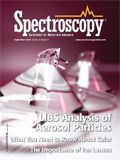From the Editor
Introduction to this month's issue by David Walsh.
As regular readers of Spectroscopy will know, the feature article in this year's August Buyers' Guide provided an in-depth analysis of the current state of the materials analysis market, and the conclusion (unfortunately) was that no, the spectroscopy market is not immune to the economic downturn that the U.S. economy is currently experiencing ("The Spectroscopy Market Hits a Bump in the Road," Lawrence S. Schmid).

David Walsh
However, amid the generally muted tone of the report were some bright spots and a definitively positive outlook for the future of the industry. And one thing that appears certain is that lasers and laser-based techniques will play an integral role in the eventual recovery of the spectroscopy market, with IR, NIR, and others trending upward. As always, Spectroscopy aims to lead the way in bringing readers the latest research on such cutting-edge techniques and methods, and this month is no exception, as evidenced by the feature, "Laser-Induced Breakdown Spectroscopy for Analysis of Aerosol Particles: The Path Toward Quantitative Analysis" by David W. Hahn. Here, further applications of LIBS are explored, with a novel application in the area of aerosol particle analysis. LIBS is associated to a large extent with areas such as homeland security research, itself a rapidly growing market segment, as seen in the June issue of Spectroscopy ("Current Status of Standoff LIBS Security Applications at the U.S. ARL," by DeLucia and colleagues), and this latest addition to the scientific literature only reaffirms the importance of this technique in the materials analysis community.
Look for more research on LIBS and other laser-based techniques in future issues of Spectroscopy, as upcoming issues will feature further installments of our "Lasers and Optics Interface" column, as well as additional laser-related content (see our October issue for LIBS analysis of complex samples such as paint, petroleum, and motor oil).
If there is a trend emerging in the field of materials analysis, you can bet our columnists and regular authors will be covering it, and LIBS research is just one example.
We hope you enjoy the issue.

David Walsh
Editor-in-Chief

LIBS Illuminates the Hidden Health Risks of Indoor Welding and Soldering
April 23rd 2025A new dual-spectroscopy approach reveals real-time pollution threats in indoor workspaces. Chinese researchers have pioneered the use of laser-induced breakdown spectroscopy (LIBS) and aerosol mass spectrometry to uncover and monitor harmful heavy metal and dust emissions from soldering and welding in real-time. These complementary tools offer a fast, accurate means to evaluate air quality threats in industrial and indoor environments—where people spend most of their time.
NIR Spectroscopy Explored as Sustainable Approach to Detecting Bovine Mastitis
April 23rd 2025A new study published in Applied Food Research demonstrates that near-infrared spectroscopy (NIRS) can effectively detect subclinical bovine mastitis in milk, offering a fast, non-invasive method to guide targeted antibiotic treatment and support sustainable dairy practices.
Smarter Sensors, Cleaner Earth Using AI and IoT for Pollution Monitoring
April 22nd 2025A global research team has detailed how smart sensors, artificial intelligence (AI), machine learning, and Internet of Things (IoT) technologies are transforming the detection and management of environmental pollutants. Their comprehensive review highlights how spectroscopy and sensor networks are now key tools in real-time pollution tracking.